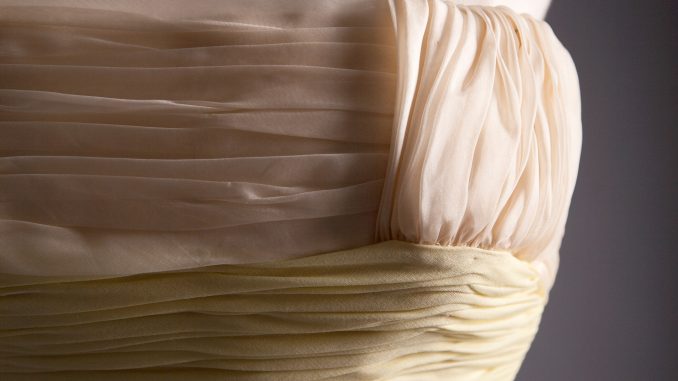
Anthony J. Drexel, founder of Drexel University, believed students must be inspired in order to succeed, rather than focusing solely on technical work.
When he founded the university in 1891, Drexel set aside $1 million, the equivalent of more than $26 million today, for art and artifacts, including textiles. Some textiles from those early years survived to make up the Robert and Penny Fox Historic Costume Collection, a collection of women’s fashion artifacts that separated from the main art collection in the mid-20th century.
Since then, the FHCC existed only as a teaching and research tool until the collection made its debut in “Immortal Beauty,” an exhibition at an on-campus gallery in fall 2015. Now, however, the collection is reaching larger audiences at the James A. Michener Art Museum in Doylestown.
“Philadelphia in Style: A Century of Fashion from the Robert & Penny Fox Historic Costume Collection, Drexel University” opened on March 13 and Louise Feder, 2013 Tyler School of Art alumna and co-curator of the exhibit, said it is already extremely popular.
“At this point we’re hoping it’ll be a badly kept secret,” Feder said. “This deserves to be shown.”
Clare Sauro, collection curator and co-curator of “Philadelphia in Style,” said roughly 14,000 fashion pieces make up the collection, which until recently has been hidden from the general public.
“The reality was they knew they had something special, but didn’t really know what to do with it,” Sauro said. “Having worked in other museums, I know that this is a really superior collection and to use it only for teaching and research is really a shame.”
“It’s not that we haven’t wanted to share our collection with the public,” Sauro added. “It’s that we just haven’t had the means to.”
When Feder and Michener Art Museum co-curator Kirsten Jensen reached out to Sauro with a gallery and an audience, the FHCC finally got the opportunity to travel out of Philadelphia.

Feder said she recognized a demand for fashion history after the Michener’s Grace Kelly exhibit brought in record numbers in 2013.
“It was really a lucky combo where we knew we had an audience and we knew we had space,” she said.
Feder said one of the most difficult challenges she faced curating the exhibit was its sheer volume. Of the 14,000 pieces, “Philadelphia in Style” includes only 34 items, spanning 100 years.
But, Sauro makes “object sheets” with strict rules, so even her favorite items get ruled out if they don’t fit into set categories.
“For [the exhibit] they had to be bought in Philadelphia, worn in Philadelphia or by a Philadelphia designer,” she said. “I was strict about hitting at least two of those three marks.”
She said she tried to think visually about the exhibit as a whole in order to create a central aesthetic, similar to what fashion designers do when they create a collection based around a particular theme or vision.
“I knew this [exhibit] was opening early spring, so I wanted it to feel joyous,” she said.
The items Sauro, Feder and Jensen chose include spring colors like yellow, pink and green, floral patterns and light fabrics like linen and lace. Sauro said by thinking about the visuals during the selection process, she could immediately rule out black, velvets and furs.
Unlike fashion exhibits in other museums, which Sauro said often focus on “the best of the best designers,” “Philadelphia in Style” revolves around the history of women in Philadelphia.
“I think fashion is one of those art forms that can be so approachable to people because we all get up in the morning and put clothes on,” Feder said.
Feder believes fashion is “instantly relatable,” and can give viewers a glimpse of different time periods.
“Objects and fashion are a really great way to tell the story. This is an immediate and more personal history,” Feder said. “My favorite jacket in the show, the fabric in the jacket was made in a North Philadelphia mill. Knowing that it was made in North Philadelphia and designed by a Philadelphia fashion designer for a Philadelphia department store is really powerful.”
“I think we have an interesting collection in that it evolved really organically and we were collecting early,” Sauro said. “[There was] no real vision, no board telling us what to do. It’s a real reflection of the tastes of early women and the people of Philadelphia.”
Erin Moran can be reached at erin.moran@temple.edu.


Be the first to comment